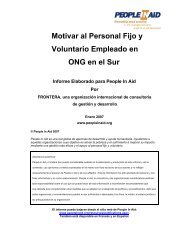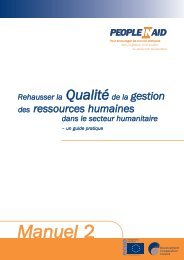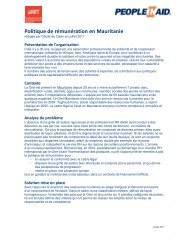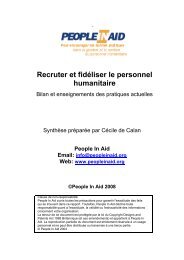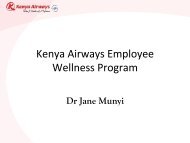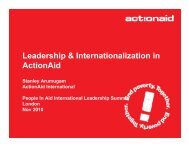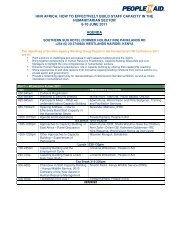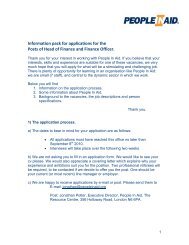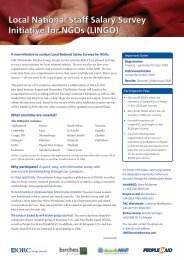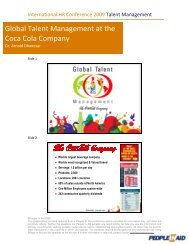EPN IAWG NAIROBI 2009 Conference Final Report - People In Aid
EPN IAWG NAIROBI 2009 Conference Final Report - People In Aid
EPN IAWG NAIROBI 2009 Conference Final Report - People In Aid
You also want an ePaper? Increase the reach of your titles
YUMPU automatically turns print PDFs into web optimized ePapers that Google loves.
<strong>EPN</strong> <strong>Conference</strong>, in association with the <strong>IAWG</strong>“Successful Change Facilitation:Strategies and Tools for the Humanitarian Sector”March 25 th – 27 th <strong>2009</strong>Jacaranda Hotel, NairobiFINAL REPORT<strong>Conference</strong> Aim:To enable participants to become better change agents, so as tosuccessfully facilitate change, and to facilitate the growth of theEmergency Personnel Network (<strong>EPN</strong>)“My understanding has really changed- this event has given methe knowledge and skills on how to handle change andwhat to expect once change is made”comment by a conference participant<strong>Report</strong> prepared by Delvine Raini and Polly Bodgener
Table of ContentsTable of Contents ................................................................................................ 1Executive Summary ............................................................................................ 2Session 1: <strong>In</strong>troduction to <strong>EPN</strong> and <strong>IAWG</strong> ............................................................ 4Session 2: <strong>In</strong>troductions and Expectations .......................................................... 4Session 3: Organisational Change in the Humanitarian Sector ........................... 6Session 4: Current Organisational Changes ........................................................ 8Session 5: Structural & Strategic Change: Rationale &The Process .................... 9WWF Case Study Presentation ............................................................................ 9Session 6: Forms of Organisation ...................................................................... 11Session 7: Recap and Reflections ..................................................................... 13Session 8: Change At GOAL Kenya: Case Study Presentation ......................... 13Session 9: Reflection on Strategies and Tools for Facilitating Change .............. 14Session 10: Successful African Change Stories ................................................ 17Florencio Marerua ............................................................................................... 17Session 11: Applying Strategies and Tools to Common Change Trends ........... 20Session 12: Being a Change Agent – Personal Strengths and Challenges ....... 24Session 13: Being a Change Agent – Personal Development Needs ................ 24Session 14: Organisational Change Actions ...................................................... 26Session 15: Suggested Change Support activities ............................................ 26Annex A: Participant List ................................................................................. 28<strong>EPN</strong>/<strong>IAWG</strong> <strong>NAIROBI</strong> <strong>2009</strong> CONFERENCE STEERING COMMITTEE ............. 29Florencio Marerua Capacity Building Advisor, WVI ......................................... 29Jonathan Potter Executive Director, <strong>People</strong> <strong>In</strong> <strong>Aid</strong> .......................................... 29Pamela Mokaya Director, HR and Admin, WWF-EARP .................................. 29Irene Adhiambo HR Manager, Goal Kenya ..................................................... 29Elizabeth Chebet Administrator, <strong>IAWG</strong> ............................................................ 29Lilian Kwamboka TCBG Administrator, <strong>IAWG</strong> ................................................. 29Jane Mutisya HR, IMC .................................................................................. 29Stephen Ng’ang’a HR and Admin Assistant, Concern Worldwide ................... 29<strong>Conference</strong> Facilitator: Polly Bodgener ............................................................ 29Training and Facilitation Services ....................................................................... 29pebodgener@yahoo.co.uk .................................................................................. 29<strong>Conference</strong> <strong>Report</strong>er: Delvine Raini ................................................................. 29delviner@yahoo.com .......................................................................................... 29Annex B: Agenda ............................................................................................. 30Annex C: Record of current organisational changes ................................... 32Annex D: WWF Case Study Presentation ..................................................... 34Annex E: Change At GOAL Kenya: Case Study Presentation ..................... 36Annex F: Resources and References ............................................................ 38Annex G: Participant Evaluations .................................................................. 39
Executive SummaryThere are few organisations in the humanitarian and development sectors thathave not or are not experiencing significant amounts of change. Sometimes thatchange has been driven by massive unanticipated external events or sometimes,change is driven by internal events. HR professionals and departments may ormay not feel included in shaping and driving change initiatives. They may needto respond to change or implement plans. Organisational change will alwayshave implications for HR departments and personnel. As one participant said,though, ‘Change has most effect on the people, not on the organisation’.Facilitating change is one of the difficult challenges that humanitarian agenciesFace. It is inevitable, and dealing successfully with it is critical to anorganisation’s success. The purpose of the conference was to help theparticipants become better change agents, so as to successfully facilitate changeand be able to come up with a strategy for the same.<strong>In</strong> this highly participative conference, participants learned from the experience oftheir peers, heard two case studies from INGOs in the region and learned ofpractical strategies and tools to help them personally to facilitate change. Adistinctive feature of the conference were the innovative approaches toorganisational change in the African context that were put forward. Ways ofdeveloping competencies for change agents were identified, and practicalmethods were suggested for this. The conference concluded with a list ofachievable suggestions for action by participants, <strong>IAWG</strong> and <strong>EPN</strong>, and with thesense that the group had become a creative change community.<strong>In</strong> the evaluations a majority of the participants felt that the conference had mettheir personal expectations and had been very useful for them. Manyparticipants stated that their ideas about change had been challenged andtransformed.Summary of Key Learning Points:Humanitarian organisations must be effective at “good change” given that theirUltimate mandate is protecting and saving lives and livelihoods.Attitudes to change were important; they determined the response to changeHR has a key role and often takes the pressure from change processes;therefore HR practitioners need preparation and support.Participation is the key to successful change; if individuals don’t embrace changeIt will not happen.There needs to be a collective responsibility for change.<strong>EPN</strong>/<strong>IAWG</strong> Nairobi <strong>2009</strong> <strong>Conference</strong> <strong>Report</strong> 2
The first stage of a change process should be creating a culture of changepreparedness: “Disaster preparedness is something we’re all involved in andchange preparedness is something we should be working towards much more.”Change should be embedded in an organisation as a cross-cutting theme, likediversity.There needs to be an emphasis on communication for understanding the change– “Communication, Communication, communication!”Change is a learning process. Use guidelines rather than a fixed step approach –remain flexible throughout the change processEvaluation, and confirmation that the objectives have been achieved, is anessential part of the change process.Small changes can facilitate bigger changes. We can all facilitate change if wehave a ‘yes, we can’ attitude and are persistent.Some comments from participants at the conference:“It has widened my horizons, expanding my scope of thinking”“Change needs some time – if you force it, it will break”“I am more equipped with skills; I am going to make a change in people’s lives”“I now understand why things work the way they do”“My organisation has recently instituted a big change – I now realize that I needto be persistent in order to make it stick”“Reawakened my creativity and innovativeness”“Practical case studies: real experience with good lessons”“Being involved in change means I can enjoy investing energy in it. All changesare on top of the day to day work”“I learned that positions of power can shift when least expected, especially whenworking in humanitarian organisations, and emotional scars are more difficult toheal when changes have occurred in an organisation”.<strong>EPN</strong>/<strong>IAWG</strong> Nairobi <strong>2009</strong> <strong>Conference</strong> <strong>Report</strong> 3
Session <strong>Report</strong>sSession 1: <strong>In</strong>troduction to <strong>EPN</strong> and <strong>IAWG</strong>Florencio Marerua – WVI; Chair, Training and Capacity Building Sub-group,<strong>IAWG</strong>Jonathan Potter, Executive Director, <strong>People</strong> in <strong>Aid</strong>, and Chair of <strong>EPN</strong>Session objective: To <strong>In</strong>troduce <strong>IAWG</strong> and <strong>EPN</strong> and get an update on recentchange events and trendsFlorencio Marerua welcomed participants to the conference and explained thatthe conference is a joint collaboration between the Emergency PersonnelNetwork (<strong>EPN</strong>) and the <strong>In</strong>teragency Working Group on Disaster Preparedness(<strong>IAWG</strong>). Two previous conferences, in 2007 and 2008, have been of greatbenefit to a wide diversity of participating individuals and organisations. One ofthe recommendations from the 2008 Nairobi <strong>EPN</strong> <strong>Conference</strong> was to examinethe challenges and the strategies faced by humanitarian HR practitioners whenfacilitating change in their organisations. A steering committee was formed toplan this year’s conference on the theme of “Successful Change Facilitation”.The <strong>IAWG</strong> provides a forum for regional organisations - international NGOs, theRed Cross and UN Agencies - to enhance information exchange and regionalcoordination in order to respond to emergencies in a timely and cost efficientmanner. The Training and Capacity Building Sub-group (TCBG) of the <strong>IAWG</strong>supports humanitarian organisations in the region through developing acoordinated approach to training and capacity building.Jonathan Potter explained that <strong>EPN</strong> is an initiative run by <strong>People</strong> in <strong>Aid</strong>, whichbrings together HR practitioners and line managers to network and discussissues related to the recruitment, retention and development of staff involved inemergency situations. <strong>EPN</strong> conferences, which have taken place in 4continents, provide a unique opportunity for HR professionals to spend time withtheir peers, to share discussions on issues they face in daily practice alongsideissues from the broader humanitarian sector that impact on the HR function. Oneof the aims of this conference was to facilitate the growth of <strong>EPN</strong> in the region.<strong>EPN</strong> Online had proved very successful in the last year in bringing peopletogether virtually to discuss and share.Session 2: <strong>In</strong>troductions and ExpectationsPolly Bodgener, <strong>Conference</strong> FacilitatorSession objective: To enable participants to get to know one another and reflecton what change means to them<strong>EPN</strong>/<strong>IAWG</strong> Nairobi <strong>2009</strong> <strong>Conference</strong> <strong>Report</strong> 4
Participants were asked to do paired introductions, giving their names, theirorganisations and their (one word) reactions to the word “CHANGE”. 1Participants had a wide range of reactions to the word “change”, reflecting theexpectations that many people have when encountering change in their lives.Change can mean “pleasure’, “fun”, “growth”, “excitement”, “creativity”, a positiveexperience when one is able to be involved and to see the benefits. Change canalso mean “tension”, “fear”, being viewed with mistrust and as a threat. Changeis often about uncertainty – “unusual”, “a new thing”, “transition”, “difference” and“haziness”, the outcome is not known and there is always the possibility ofconfusion about the change, “of what?” It was clear that attitudes had aninfluence on the process and on the outcomes of change.<strong>In</strong> response to this straw poll of reactions to change, participants discussed intriads some of their personal stories of change – What was the change? Whathappened? How did they feel about the change? <strong>In</strong> the following open groupdiscussion, some of the personal learning points people had from theirexperiences were:• Responded negatively at first• Found it challenging• Felt judgmental at the start• Became more open• Learned to accept• Enlightened by the process of change• Learned to be patient• Became more tolerant• Attitudes to change were important, they determined the response tochange• Needed to look at the positive sideThe Kübler Ross model 2 of the five stages of grief was introduced as oneperspective for understanding our own and other people's emotional reaction topersonal change, irrespective of cause.• Denial• Anger• Bargaining• Depression• Acceptance1 Difference; Alternative; Attitude; Tension; Fun; Learning ; Newness ; Exciting; Transition;Pleasure; Fear; Abrupt; <strong>In</strong>novation; Unusual; Transform; Open minded; Focus forward; Growth;New thing; Of what?; A step ; Haziness; Opportunity; Creativity2 www.elisabethkublerross.com; www.davidkessler.org; www.businessballs.com<strong>EPN</strong>/<strong>IAWG</strong> Nairobi <strong>2009</strong> <strong>Conference</strong> <strong>Report</strong> 5
This was related to a model on the Phases of Change 3 , which outlined somestages experienced when undergoing change, and linked these stages to a timecontinuum:• Immobilization• Denial• Frustration• Acceptance• Practice• Realization• <strong>In</strong>tegrationSummary of Key Learning Points:Change produces a wide range of emotional responses in people, includingfeeling a victim of change rather than a part of it.Attitudes to change can determine the response to the change. Responses willdiffer according to whether change is seen as a loss or as a gain.Change is about uncertainty and can be confusing; clear information andcommunication is needed to help understand the change processChange takes time and there are defined stages in the process of responding tochangeSession 3: Organisational Change in the Humanitarian SectorPolly Bodgener, <strong>Conference</strong> FacilitatorSession objective: To outline some key concepts related to organisationalchange in the humanitarian sectorWhen considering change in the humanitarian sector, and in the participants’organisations, it is necessary first to examine the context of humanitarian workand the changes in this context over time. Participants were asked to identifysignificant external changes which impacted on the humanitarian sector andcaused internal changes in their organisations.Participants’ Identified External Changes<strong>In</strong>crease in number, scale and types of disasters (and in number linked to climatechange)<strong>In</strong>crease in number of NGOsPerceptions and approaches (what is being done)Donors and compliance<strong>In</strong>security and instabilityEthics and principles3 “Success with Change” www.trainerbubble.com<strong>EPN</strong>/<strong>IAWG</strong> Nairobi <strong>2009</strong> <strong>Conference</strong> <strong>Report</strong> 6
Politicization and the role of the stateReactive responsesFundingSkills base – personnel changes; focus on national staffAccountability – beneficiaries and donorsFrom this exercise, it was clear that the humanitarian sector is linked to a widevariety of external change factors. <strong>In</strong> a recent review of organisational change inthe humanitarian sector 4 , the following external changes were identified ashaving significant internal change implications for humanitarian organisations:• increase in the number and scale of emergencies• changes in funding for humanitarian action• the scope of assistance has expanded since end of the Cold War• the type of assistance has expanded and changed (complex emergencies;military involvement; advocacy and rights-based approaches)• the humanitarian sector has grown tremendously, as traditionalhumanitarian agencies have expanded and been joined by new actors(INGOs, NGOs and CBOs)• humanitarian agencies have changed in nature - influence of donors andchanges in organisational culture in the global North; quality-improvementprogrammes; inter-agency coordination mechanisms; technologicalchanges in communication• increased interest of public and media, more internal analysis and sectoralaccountability mechanisms• donors have become significantly more involved in humanitarian issues,and there is increased politicization of humanitarianism• changes to traditional principles of neutrality and proportionality –introduction of the Humanitarian Charter• <strong>In</strong>creased security risks - humanitarian workers targeted by armed groups,changing practice to enhance the security of staff and beneficiariesThe review linked changes in the wider context to internal changes in skill base,strategic orientation, structures, operating procedures and management systemsof many humanitarian organisations, and cited some recent examples of thesetypes of organisational changes (see table below).4 “Organisational Change <strong>In</strong> The Humanitarian Sector”, in the Review of Humanitarian Action(7),Ch 2 Paul Clarke and Ben Ramalingam www.alnap.org/publications/7RHA/ch2.pdf<strong>EPN</strong>/<strong>IAWG</strong> Nairobi <strong>2009</strong> <strong>Conference</strong> <strong>Report</strong> 7
Some recent examples of these types of organisational changes 5Emergency Capacity Building project – inter-agency cooperationIFRC – consolidation project to create regionally based ‘zonal offices’Oxfam <strong>In</strong>ternational – implementing a single, common Emergency strategywithin the Oxfam <strong>In</strong>ternational familyDFID – strengthening humanitarian donorshipAction <strong>Aid</strong> – rights–based approaches in emergency workUN WFP – introduction of results-based managementValid <strong>In</strong>ternational – introduction of community-based therapeutic feedingWorld Vision <strong>In</strong>ternational – building the capacity to learn through the H LearnProjectIslamic Relief – planning and implementing a humanitarian strategyICRC – strategic and structural changes in the last decadeSummary of Key Learning Points:“Only change is constant” - humanitarian organisations are continually adapting,finding a balance between global trends and local pressures.Change in humanitarian agencies has been profound and wide-reaching. Therehave been large-scale changes to what humanitarian organisations are, and inhow they work.Humanitarian organisations have the potential to do more than react to changesin the external context. There are many examples of organisations makingconscious choices about how they want to change.Changes create change - changes that humanitarian organisations make tothemselves also affect and alter the humanitarian context.Humanitarian organisations must work to ensure that they have adequatecapacities for successful change… they need to be “good at good change”; giventhat their ultimate mandate is protecting and saving lives and livelihoods.Session 4: Current Organisational ChangesPolly Bodgener, <strong>Conference</strong> FacilitatorWorking GroupsSession objective: To identify some of the organisational changes thatparticipants are currently engaged in5 Page 28, “Organisational Change <strong>In</strong> The Humanitarian Sector”, in the Review of HumanitarianAction (7),Ch 2 Paul Clarke and Ben Ramalingam<strong>EPN</strong>/<strong>IAWG</strong> Nairobi <strong>2009</strong> <strong>Conference</strong> <strong>Report</strong> 8
“What current changes are you engaged in/having to address in yourorganisation?”Participants were asked to individually note answers to the above question topost up on a wall, and to then sort these answers into clusters aroundorganisational change themes. Participants then self-selected a theme theywanted to discuss in a group, to identify some common trends surrounding thecurrent organisational change processes they were engaged in (see Annex C).The common trends highlighted in this session were then discussed in Session11, when strategies and tools to apply to these changes were examined.Summary of Key Learning Points:Participants were involved in a wide range of organisational changes; levels ofengagement in the changes varied from direct responsibility for the process toconcern about the impact of wider changes on their work.HR practitioners at the conference were currently engaged in organisationalchange at strategic, structural, funding, procedural, staffing and culture levels.Change interventions varied from detailed work on operational and staffexpenses to organisation-wide initiatives on ways of working and resourcedevelopment.Session 5: Structural & Strategic Change: Rationale &The ProcessWWF Case Study PresentationPamela Mokaya, Director, HR & Administration, WWF-EARPOSession objective: To review a recent approach to organisational change in anINGO in the regionPamela outlined a recent organisation-wide process in WWF which entailedmajor strategic and structural changes. Following an organisational review, it wasrecognised that the organisation’s strategy and the way the business workedwere not in harmony. HR, finance and administration support were not keepingpace with the growth of programmes.The change process was clear, the objectives set out and communications wereplanned carefully. The key lessons learnt were to have realistic timeframes andto expect to have to adapt the process as it developed. A full record of the casestudy presentation is in Annex D.THE CHANGE PROCESS• Identification of change champions• Composition of the change team• Clarifying change objectives• TORs<strong>EPN</strong>/<strong>IAWG</strong> Nairobi <strong>2009</strong> <strong>Conference</strong> <strong>Report</strong> 9
• Gaining their support and training them for the job• Agreeing on a united front• Communication strategy• Tasks for each individual team members• Action plan/ time table for the changeOPPORTUNITIES GIVEN BY CHANGE• Efficiency gains i.e. being able to move the staff to the project sites• Project rationalization• “Opportunity to clean house and get rid of excess flap”• Attitude/culture change• Global standardisation of working practicesCHALLENGES FACED BY WWF• Lack of buy-in from change agents or staff members• Anxiety and low staff morale which affected performance• Financial constraints• Legal challenges - Contracts with communities which were not complete• Challenge of physical separation• Redundancies/possible litigationsRECOMMENDATIONS• Important to have a compelling change story• Develop objective criteria for selection of change team members i.e. pickpeople of integrity• Clear terms of reference for the change team• Develop a communication strategy and identify the lead communicator• Understand the issues at play i.e. transparency• Be open and transparent to avoid unnecessary gossip• <strong>In</strong>form partners of the intended change in good time• Change has taken place because the mandate has changed.Summary of Key Learning Points:It takes a long time for people to accept change.Change has to start from within. If individuals don’t embrace change it will nothappen.Change is brought about by creativity and innovation.Part of the change process is that it keeps changing. Flexibility needs to be builtinto the change process – there needs to be ways of identifying if it is notworking, or if the approach is wrong.Clear communication and transparency are important at all stages of the process<strong>EPN</strong>/<strong>IAWG</strong> Nairobi <strong>2009</strong> <strong>Conference</strong> <strong>Report</strong> 10
Session 6: Forms of OrganisationPolly Bodgener, <strong>Conference</strong> FacilitatorSession objective: To reflect on different forms of organisations and how changeaffects themThe purpose of this exercise was to highlight the need to explore what‘organisations’ actually are in order to challenge assumptions about howorganisations change, and to choose strategies and tools to facilitateorganisational change successfully.Participants were asked to first visualise their organisations and to describe theimage to the group. Some of the images are given below, nearly all being lifeforms. It was suggested that the strategy needed to make changes to a lion maybe very different to that needed to bring about change in a ship.A tree: the roots of the tree (senior management) must be strong so that the restwill grow strong and the branches are supported well.An eagle: able to fly high to have vision and focus.A chameleon: able to change its colors gradually so as to fit in any environment.A lion: where the staff are afraid of the CEO, they are also alert to his leadershipstyle.A circle: where many are enclosed by holding hands as they work.A ship: large, heavy and set in its course, it takes a long time to change direction.A bear: taking different positions as it changes (sitting, crouching, standing…).A tortoise: steady and focused on where it is goingA child: still learning to walkFour types of organisational form were presented for participants to consider inrelation to the type of change strategies and tools to adopt for organisationalchange. These types summarize current and evolving theories about whatorganisations are and how they respond to change. 6Organisation as a Machine• inputs and outputs• organisational charts• language of ‘technical’ recommendations, ‘levers’ for change,‘restructuring’ ‘re-engineering’• emphasis on maximum efficiency• the sum of their parts – production valued• can be acted upon by the provision of tools, techniques and codes6 Summarized from pages 35 - 36 , “Organisational Change <strong>In</strong> The Humanitarian Sector”, in theReview of Humanitarian Action (7),Ch 2 Paul Clarke and Ben Ramalingam<strong>EPN</strong>/<strong>IAWG</strong> Nairobi <strong>2009</strong> <strong>Conference</strong> <strong>Report</strong> 11
Organisation as a Community• a distinct social structure and a culture• own values and beliefs• variety of elements: a legal personality; an organisational design; writtenrules; identified members and premises• communal view of how the world is and of how the organisation should bein the world• the informal is important as the formal when implementing changeOrganisation as a Mind• an intelligent, reflective entity• understands, responds and learns• emotional decisions and responses• individual needs: control, inclusion, emotional closeness• organisational needs: belonging/bonding• protection and defense of the organisation’s being• change can be implemented from testing, evaluation and learningprocessesOrganisation as a Complex Adaptive System• Behavior principles like natural complex systems (the weather, the humanbody…)• dynamic, unpredictable• elements in constant interaction• intricate web of relationships• organic and self-regulating• different directions at different speeds• one part affects all the others• change implementation can be unpredictable, all the elements need to beconsideredSummary of Key Learning Points:No one organisational form is the ‘right’ one - organisations are complex systemscomposed of people.Using metaphors or analogies can highlight the organisation’s culture andsuggest how the organisation might respond to change.Organisational development theory can be used to reflect on what humanitarianorganisations are and how they work, and what strategies and tools would beappropriate to successfully facilitate change<strong>EPN</strong>/<strong>IAWG</strong> Nairobi <strong>2009</strong> <strong>Conference</strong> <strong>Report</strong> 12
Session 7: Recap and ReflectionsSession objective: To review the learning so far.Participants were asked to share the key change points that they had reflectedon from the first day of the conference.• Change is painful, but inevitable.• The challenges presented from the WWF case study.• The leader of the change has to think in terms of ‘We’ not ‘Me’.• What motivates change is important.• Change is not simple; it needs to be prioritized and planned.• Change needs time.• Participation is the key to successful change.• Communication is vital; you can’t do it alone.• Change is a full circle – one area impacts on another – need to look at theoverall ‘fit’ of the change.• The changes need to be matched to personalities and attitudes.• Change means different things to different people – you need to be clearwhich side of the fence you are on.Session 8: Change At GOAL Kenya: Case Study PresentationIrene Adhiambo, HR Manager, GOAL KenyaSession objective: To review a recent approach to organisational change in anINGO in the regionIrene outlined a recent organisational change process that was forced by aneconomic crisis. This meant that there would need to be staff reductions andrelocations, organisational restructuring and some fundamental changes inorganisational approaches. The change was abrupt and had to be implementedrapidly.The result has been new staff and a new shared understanding of sustainabilityand accountabilities. HR’s role was critical: ‘everybody’s looking up to you’; ‘youhave to tell us something good at the end of the day’. A full record of the casestudy presentation is in Annex E.THE PROCESS OF THE CHANGE1. Had meetings with staff to involve them in the amalgamation process andalso get their views.2. Budget was reviewed so as to cut costs.3. Communication was done through emails and meetings at project levels.4. Some staff were terminated and the new positions advertised. Anopportunity was given to the existing staff to also apply for these positions.<strong>EPN</strong>/<strong>IAWG</strong> Nairobi <strong>2009</strong> <strong>Conference</strong> <strong>Report</strong> 13
THE OUTCOME OF THE PROCESS• <strong>In</strong>itial lack of trust and confidence to the change encountered afterreducing the staff• Different ways of doing things both at the projects and support levels.• Budget cuts• Anxiety - people are now alert to know what is happening• Change of policies and procedures• More focus on sustainability• There is a better accountability processBENEFITS OF THE CHANGE• There is improved communication• Attitudes have changed• Better focus on sustainability and accountability• Able to work as a team• Staffs are now more positive and confident.Summary of Key Learning Points:<strong>In</strong> this example, HR had a key role and took the pressure from the changeprocess; there needs to be preparation and support to HR practitioners whenimplementing organisational change.Change can be abrupt when responding to a crisis – the reason for changeneeds to be clearly communicated and there needs to be preparation formaintaining staff morale.Session 9: Reflection on Strategies and Tools for Facilitating ChangeIrene Adhiambo and Pamela MokayaSession objective: To review some strategies and tools for facilitatingorganisational change in the humanitarian sector.An open plenary reflection was held, drawing out some strategies and toolspresented in the two case studies and taking experiences from the participants.The discussion centred on strategies and tools to engage and motivate staffinvolved in major organisational change.− Try to look for external experts to assess staff capacities for change; forexample, meet with the existing staff separately from newly appointed staffand get their views and suggestions on what they feel the new staff tookaway.− Also, external experts can encourage staff to look at issues beyondmoney, such as trying to maintain or create a new image of the<strong>EPN</strong>/<strong>IAWG</strong> Nairobi <strong>2009</strong> <strong>Conference</strong> <strong>Report</strong> 14
organisation. This can also be done through staff associations, such aswelfare department meetings.− External experts can help staff to speak out; by creating a neutral rapportthey can help staff to vocalize their problems.− Help staff to understand what their role is and what is expected of them,thus help to reduce high demands on HR.− Have a new planning tool, for example, each staff member indicating theirtime sessions.− Justice reflection workshops: This can help staff to look at the worldthrough a justice lens, reminding them of the organisation’s mission andaddressing poor inter-staff relationships.− Use of team building workshops.− Building trust is not easy and it is not easy for people to open up, thereforea blind feedback system can be useful. For example, asking people togive suggestions in anonymous written form, which can be sampled foranalysis and discussion.− HR staff needs to change their attitudes first, by appreciating staff, andthen the whole staff can be able to work as a team.− Creating awareness and educating staff will help them to cope with anykind of crisis.− Use of meetings to consult and update staff regularly on changes, even ifthere has been no change.− Important to have inductions and orientations for new staff to raiseawareness of current changes and of the attitudes of existing staff.− Change champions are important to influence attitudes and createcommitment to the changes.− A suggested model to use for a change process is: <strong>In</strong>quire; inform;involve; Implement.− Create Change Forums to exchange information, network and supporteach other.− Find a Change Buddy, someone you trust to whom you can go and talk orjust spend some quiet time with.<strong>EPN</strong>/<strong>IAWG</strong> Nairobi <strong>2009</strong> <strong>Conference</strong> <strong>Report</strong> 15
− If there is a culture of nepotism, there will always be suspicion as to howsomeone got their job. A proposed tool was to “forget names and startafresh with what you see yourself, and others, as being”.Harvard Professor John Kotter’s 8 step process 7 for successful change wasintroduced as a model strategy. This change process takes time and goesthrough several different phases in a successful change effort. A mistake madeduring any phase of the change effort can have a negative impact on theorganisation.KOTTER’S 8-STEP CHANGE FRAMEWORKSET THE STAGE1. Create a Sense of Urgency.Help others see the need for change and the importance of acting immediately.2. Pull Together the Guiding Team.Make sure there is a powerful group guiding the change—one with leadership skills, bias forAction, credibility, communications ability, authority, analytical skills.DECIDE WHAT TO DO3. Develop the Change Vision and Strategy.Clarify how the future will be different from the past, and how you can make that future aReality.MAKE IT HAPPEN4. Communicate for Understanding and Buy-in.Make sure as many others as possible understand and accept the vision and the strategy.5. Empower Others to Act.Remove as many barriers as possible so that those who want to make the vision a reality canDo so.6. Produce Short-Term Wins.Create some visible, unambiguous successes as soon as possible.7. Don’t Let Up.Press harder and faster after the first successes. Be relentless with instituting change afterChange until the vision becomes a reality.MAKE IT STICK8. Create a New Culture.Hold on to the new ways of behaving, and make sure they succeed, until they become a partOf the very culture of the group.“The Story of the Eagle”Mohamed Ibrahim Nur, Human resources Manager, HijraSomaliaDuring the session, a participant volunteered to show a brief presentation of achange story, based on the life-cycle of an eagle 8 . This story outlined the7 “Our Iceberg is Melting: Changing and Succeeding Under Any Conditions” John Kotter & HolgerRathgeber; www.johnkotter.com8 “The story of the Eagle” PPT presentation available from m.ibrahim@hijrasomalia<strong>EPN</strong>/<strong>IAWG</strong> Nairobi <strong>2009</strong> <strong>Conference</strong> <strong>Report</strong> 16
change process which an eagle takes during its life, whereby it has to make adifficult choice at maturity to either undergo a painful self-renewal or to die.The key messages from this presentation were:- Many times, in order to survive, we have to start a change process.- We sometimes need to get rid of old memories, habits and other pasttraditions.- Only freed from past burdens, can we take advantage of the present.Session 10: Successful African Change StoriesFlorencio MareruaSession objective: To practice developing a change strategy and identifyingappropriate toolsParticipants divided into four groups and were asked to develop a changestrategy with appropriate tools which would reflect an African perspective ofsuccessful change. It was noted that Africans lived in an unstable environmentand that change was a part of our lives.Group name: “The Mirror”ApproachAfrican experience of change has made us resilient and humble, open to changeand flexible in our approach. We are capable of looking at ourselves andreflecting on what we see.Process1. Feasibility study2. Communication3. Change team (involvement)4. Collective responsibility5. Strong/decisive leadership6. Redundancy package7. Ring fencing jobsStrategyIdentifying a Task ForcePlanning/Feasibility studyCommunicationExternal opinionToolsCommunication – participatoryTraining<strong>EPN</strong>/<strong>IAWG</strong> Nairobi <strong>2009</strong> <strong>Conference</strong> <strong>Report</strong> 17
PlanningChange AgentsRecommendationsThere must be:Genuine need for changeRight attitude from the teamTimelinesParticipatory approachSharing experiences by organisations (avoid reinventing the wheel)Group name: “Butterfly”ApproachAs humanitarian organisations, we need to adopt the lessons used for disasterpreparedness and mainstream a change preparedness approach in ourorganisations. We need to be prepared for change and the transformations thatresult from it.StrategyCommunicating need and urgencyCreating Transformation Teams and methodsAction planToolsEmpowering peopleAmalgamation of winsRealistic timeframeRecommendationsThere must be sensitization and awareness-raising at all stages, to instill anattitude of change preparedness and to inform and motivate the process.Group name: “The Transformers”ApproachThe focus is on involving staff at different levels at different stages, developing aparticipatory approach throughout the process and emphasizing the importanceof communication at all times.Strategy1. Identify the need for change, or acceptance of the change if not planned2. Planning phase- Well-developed plan- Transparency/well-defined criteria<strong>EPN</strong>/<strong>IAWG</strong> Nairobi <strong>2009</strong> <strong>Conference</strong> <strong>Report</strong> 18
- Staff participation (staff association member)- Cultural differences taken into account- Staff support3. Communication- information sharing/brainstorming/discussions- 2-way communication!- All staff participation- Creating ‘safe environment’4. Implementation- on-going discussions- adjustments along the way- monitoring5. Evaluation and outcome sharingToolsStaff participation through all phases (1,2,3,4,5)2-way communicationSurvey – evaluationRecommendations1. Communication2. Communication3. CommunicationGroup name: “Group 4”ApproachThe focus was on how to approach changes with staff employment andredundanciesStrategy1. Percentage of salary paid to a provident fund2. Encourage continuous personal development3. Focus on understanding by each participant group (not on communication)4. Don’t engage in excessive consultation (too many solutions and raisedexpectations/reduce level of democracy)ToolsBaraza 9 or Kamakunji 10The right influential person to pass message on from staff to management(spokesperson)Task force9 Baraza is a village meeting convened by the elders10 Kamakunji is an opportunity offered to the people to shout at their leaders<strong>EPN</strong>/<strong>IAWG</strong> Nairobi <strong>2009</strong> <strong>Conference</strong> <strong>Report</strong> 19
RecommendationsUse a bottom-up approach to plan changeHeadquarters involved at startPlan well before the change process startsSummary of Key Learning Points:Some innovative approaches emerged from the presentations. When combined,the unique perspective from the groups’ African experience with successfulchange contained these elements:• Collective responsibility for change• The influential role of key spokespeople• Creating a culture of change preparedness• Transformative nature of change• Development of a Change team or Task force• Emphasis on communication for understanding• Use of social perceptions to alter attitudes• Building a bottom-up approach (participation at different levels at differentTimes)• Using guidelines rather than a fixed step approach – remaining flexibleSession 11: Applying Strategies and Tools to Common ChangeTrendsJonathan Potter and Polly BodgenerSession objective: To explore methods to address common organisationalchange issues for HR change agentsParticipants reviewed the current organisational change issues they hadidentified in Session 3 and summarized these issues into four areas.StaffCapacity buildingSkillsWelfareRetention strategiesCommitment and engagementManaging peopleProceduresPreparing for assessment and strategyDeveloping policies and proceduresCommunicating change and decision-makingCost-cutting office and operational costsMonitoring and evaluationOrganisational CultureProcess, tools, techniques for managingpeopleAttitudes and ways of thinkingCreating buy-in for changeUnderlying, informal changeLinks to organisational strategyStructureSenior management changesRelocation of officesDepartmental shifts – responding to differentissuesOverall restructuring- changing functions andreporting linesWays of working – partnering; using nationalstaff capacity; outsourcing<strong>EPN</strong>/<strong>IAWG</strong> Nairobi <strong>2009</strong> <strong>Conference</strong> <strong>Report</strong> 20
Participants used the ‘World Café’ method to examine these trends in detail andto discuss strategies and tools to facilitate the changes needed. One more areawas identified for discussion – “No change” – for situations where change shouldbe happening but was not. The ‘World Café’ method fostered a peer mentoringprocess ensuring individuals received insights into issues they were facing. Theoutputs from this session are practical guidance notes, from participants’experience, for facilitating change in a range of individual change scenarios.STAFF1. Poor planning and coordination− Develop and implement clear staffing plans2. Lack of proper communication channels and unclear information− Put procedures in place with close coordination to the relevantdepartmental heads3. Lack of information for staff on policies and procedures− Staff inductions and reorientations for older staff− Issue constant reminders and circulate clear staffing rules− Send memos and note responses from staff4. Acceptance of performance development and implementation− Use of performance contracts− Implement staff development programmes and encourage personaldevelopment− Use consultants/external advisors for reclassification− Consider ways of ensuring confidence in job security− Provide rationale for changes in job descriptions and grading5. Managing people through change− Develop understanding of the people being managed – pull out of thecomfort zone and understand the ‘chemistry’ of change− Provide mentoring− Continuous employee engagement through for example the <strong>People</strong> <strong>In</strong> <strong>Aid</strong>Code− Develop acceptance that it takes time to see the results of change− Ask for help, delegate and communicateCULTURE1. Establishing a learning culture− 30 minute educational sessions− Leadership that is open and shares knowledge− Ensure staff have access to proposals2. Understanding the culture of an organisation− Find out the unwritten rules and the politics− Meetings to discuss goals and objectives− Openness and transparency about the reality (managers/HR)3. Challenges in changing an organisation’s culture− Resistance to the change<strong>EPN</strong>/<strong>IAWG</strong> Nairobi <strong>2009</strong> <strong>Conference</strong> <strong>Report</strong> 21
− Changing the rules does not change the culture− Owning the change is more likely to change the culture− Communicating where the staff are in the change− Its not about ‘me’, its about the group− Getting people to be open, creating trust− Lack of effective change agents− Fear of change4. Creating a more transparent culture− Avoid victimization− Open recruitment process− Performance agreements, not appraisals− Leadership is open5. The rules don’t match the culture− Guard against hoarding knowledge− Training sessions− Encouraging a team feeling− Importance of having an open culture− Creating efficient communications – everyone is on the same page− <strong>In</strong>stitutionalize rather than personalize6. Overcoming the challenges− Understanding the history – why it is the way it is− Communicating the benefits− Participatory/owning the change− Allow people to determine if they fit with the changePROCEDURES1. Updating policies /procedures− Get approval to update manuals – Senior Management Team needs tosign off on changes− Identify the ‘Quick Wins’, for example new Labour Laws− Preparedness for change – carry out a staff survey to unearth the issues− Recording and notification of what issues are arising e.g. securityincidents2. Coping with abrupt change− Have a strategy in place including staffing, finance, and materials. Thisshould also be part of staff induction, and there should be annualreorientation for staff− Abrupt change can be positive, for example, hiring new staff− Everyone engaged in the scenarios relative to contingency planning(examples of abrupt change could be Darfur – government expulsion;Avian Flu; funding cuts)3. Who makes the decisions that change is needed?(<strong>In</strong>ternal drivers only)− Staff meetings where staff should be allowed to air an issue and pass it upand SMT must then respond.<strong>EPN</strong>/<strong>IAWG</strong> Nairobi <strong>2009</strong> <strong>Conference</strong> <strong>Report</strong> 22
− Providing evidence that change is needed e.g. security incidents andreward benchmarking− Ensure that policies have no loopholes and have proper accountabilityfrom staff.4. Reduce office expenditure− By comparing relative cost e.g. taxis vs. drivers− Prepare for reactions e.g. what else will people say can be cut, whichjourneys will be seen as irrelevant− Get support from the topSTRUCTURE1. Change from project to program− Check that Project manager will have full powers to perform2. Changing organisational structure to suit the reporting lines− Changing job descriptions− Important to clearly indicate the reporting lines− Communicate structural changes− Prepare staff for structural changes3. Change in location of head office− Communicate to staff the need/rationale for change of location4. Structure should be open and clear to all staff− Annually review the structure; this helps the organisation plan better− Staff can check themselves and see if they suit the organisation or not− Constant communication to clarify the structure to staffNO CHANGE1. Reasons for no change− Lack of genuine need to change− Vested interest of power-holders− Lack of proper communication channels− Lack of action to bring change− Lack of genuine support by management− Rigid attitude− No time− Being biased/favoritism2. Strategies to deal with No Change− Revolutionize process from bottom-up− Replace biased top management – use middle managers− Create an organisational platform− Build alliances and develop solidarity− Provide training for critical individuals− Exposure of inefficiency− <strong>In</strong>formal influencing and lobbying− Risk getting fired!<strong>EPN</strong>/<strong>IAWG</strong> Nairobi <strong>2009</strong> <strong>Conference</strong> <strong>Report</strong> 23
Session 12: Being a Change Agent – Personal Strengths andChallengesPolly Bodgener, <strong>Conference</strong> FacilitatorSession objective: To reflect on personal strengths and challenges as an HRchange agentParticipants identified some key attitudes, skills and knowledge needed to be asuccessful change agent in their organisations. <strong>In</strong> addition, they identified someexternal attributes that were necessary to enable them to facilitate change.Participants then spent quiet time reflecting on these competencies andidentifying their personal strengths and weaknesses in relation to them – rankingeach one from 5 to 1, where 5 = very able/very confident and 1 = Not able/notconfident.Change Agent CompetenciesATTITUDES SKILLS KNOWLEDGE ATTRIBUTESpositiveopen minded/ toleranthonestproactivepersistentflexibleauthenticneutral/impartiallisteningpresentingnegotiatingempathizinganalyzingplanningprioritizingdecision making<strong>In</strong>stitutionalCulturalSectoral/contextPsychologyAnthropologyChange models andprocessOrganisationalAuthorityImpartialityResourcesAccesssensitivefacilitatingdevelopmentcreativeself care & control Self knowledgeenthusiasticExternal supportSummary of Key Learning Points:Being a successful change agent requires development of a set of specificattitudes, skills and knowledgeChange agents depend on external attributes in order to successfully facilitatechange – they cannot operate in isolationSession 13: Being a Change Agent – Personal Development NeedsPolly Bodgener, <strong>Conference</strong> FacilitatorSession objective: To identify personal development needs and explore methodsto address these needs<strong>EPN</strong>/<strong>IAWG</strong> Nairobi <strong>2009</strong> <strong>Conference</strong> <strong>Report</strong> 24
Participants did a blind ranking exercise on the table of competencies to highlightthe group’s main change development needs in attitudes, skills and knowledge.A plenary discussion explored suggestions and methods for meeting the highestranking development needs.Being Persistent (6)− Keep your focus− Understand the politics/agenda− Develop patience− Understand other’s approaches− Allow time− Follow-up the change – has it happened?− Have contingency plans/options− Pace yourselfBeing Creative (5)− Brainstorming and sharing of ideas− Build your confidence - take risks− Gain access to resources− Networking− Find a creative community (like the conference group)Self-care skills (6)− Get management support− Ask for help – delegate and share responsibility− Find a mentor or use a buddy system – a safe place for venting− Maintain a work/life balance− Use a peer support group – train peer supportersPlanning skills (4) and Facilitating skills (3)− Skills training through workshops, coaching, mentoring− Practice and feedback opportunitiesChange models and processes knowledge (9)Organisational development knowledge (4)Cultural knowledge (3)− Knowledge development for all three areas could be done throughresearch, information exchange forums (like <strong>EPN</strong> on-line) andcomparative exercises with other organisations (use case studies)− Self-study and on-line learningOne organisation present had a peer support network consisting of a few peoplewith the skills and time to give to those needing to talk safely. It was understoodthat not everyone wanted to talk to HR and that management was too busy ordidn’t have the answer to others’ problems.Participants were asked recommend resources that they had found useful whenfacilitating change and to pool these so that the group could benefit from<strong>EPN</strong>/<strong>IAWG</strong> Nairobi <strong>2009</strong> <strong>Conference</strong> <strong>Report</strong> 25
everyone’s experience (see Annex F). There was also a commitment to continuethis sharing by sending recommendations to each other and through the <strong>EPN</strong>.Session 14: Organisational Change ActionsBetty Kimari, Capacity Building <strong>In</strong>tern, WVISession objective: To identify practical actions that participants would undertakein their organisations following the conferenceParticipants were asked to identify some immediate practical changes that theywould begin to make when they returned to their organisations. A few examplesare given:-− Review salary structure for national staff – can be done quickly and willmake a big change in values and equity.− Changes in staffing policy – what can be done about terminal benefits;introduce the change to management and employees and communicatethe importance of the change.− Begin to look at gender issues and see how changes can be made toworking with diversity.− Change my office environment so that it is more welcoming and peaceful.− Begin to gather evidence and statistics to make the case for change.− Make small changes that can lead to bigger ones, be a “small mosquito”.− Small things, such as this <strong>EPN</strong> conference, will make a difference, throughopening up and sharing, getting exposure; it starts the process and getspeople asking “why?”− Sign up to <strong>EPN</strong> on-line.Session 15: Suggested Change Support activitiesFlorencio MareruaSession objective: To suggest “Ways forward” for future <strong>IAWG</strong>/<strong>EPN</strong> supportactivitiesGroups were asked to suggest some practical actions that could be supported bythe <strong>IAWG</strong> and <strong>EPN</strong>/<strong>People</strong> in <strong>Aid</strong>, and by the change community created at thisconference. These suggestions can be used as a guide for planning futureactivities, dependant on availability of resources and funding.ACTVITY ACTION WHOFollow up a change Opportunities for <strong>EPN</strong> Onlineprocessdiscussion e.g. on linePlanningSelection of theChange Agentsappropriate toolCase Study Follow up of the results Pamela and IreneHR Network <strong>In</strong>troduction of the John and Geoffrey<strong>EPN</strong>/<strong>IAWG</strong> Nairobi <strong>2009</strong> <strong>Conference</strong> <strong>Report</strong> 26
Network in UgandaNetworkingEmail group e.g. Face Ourselvesbook etcRegistering on <strong>EPN</strong>Follow up workshop To be organized by <strong>IAWG</strong><strong>IAWG</strong>Change Standard We can come up with a <strong>EPN</strong> / ourselves/ <strong>IAWG</strong>Operating Procedures basic SOP based on ourexperiences and withinput from othersFun Activities Parties I AWG/ourselvesAssessment before To check on skills for <strong>EPN</strong>/ <strong>IAWG</strong>trainingservice deliveryOrganize a workshop forSMT in facilitatingchangeSlogan: “From being partof the problem to beingpart of the solution”Organizing a workshopTraining<strong>EPN</strong> /<strong>IAWG</strong><strong>IAWG</strong> organize actionlearning sets aboutchangeLessons learnt fromKenyan NGOs on howthey dealt with the postelection violenceamongst staffSteering group andadvertiseCase Studies / Research<strong>IAWG</strong><strong>IAWG</strong> and <strong>People</strong> <strong>In</strong> <strong>Aid</strong>Change Preparedness “Top Ten Tips” paper <strong>EPN</strong>Enhancing coaching andmentoring and facilitationSkillsWorkshops<strong>People</strong> <strong>In</strong> <strong>Aid</strong> and <strong>IAWG</strong><strong>In</strong>troducing Peer socialsupport teamCollection of Africanproverbs related tochangeHow to do It - briefingpaperCollect and put on ashared siteCAREPolly/other volunteers<strong>EPN</strong>/<strong>IAWG</strong> Nairobi <strong>2009</strong> <strong>Conference</strong> <strong>Report</strong> 27
Annex A: Participant ListName Designation Organisation Telephone E mailJ.K Teprey WHO 0733-330 100 Tepreyj@ke.afro.who.intPeter N Gikandi Accountant Access Kenya 0722-714 716 karatinainiative@yahoo.comMumbi Kahiu HR Manager Catholic ReliefServices0735 000 300 mkahiu@ke.earo.crs.orgStephen Ng’ang’a HR and Admin Asst ConcernWorldwide0722 581 404 stephen.nganga@concern.netEdith Karanja HR Department IOM 020-4444174/67 ext ekaranja@iom.int126/0722 389 550Jonathan Potter Executive Director <strong>People</strong> <strong>In</strong> <strong>Aid</strong> +44 (0) 20 3095 3951 Jonathan@peopleinaid.orgMohamed Ibrahim Human Resource Hijra Somali 020-3749280/0721 m.ibrahim@hijrasomalia.or.keNurManager5857730Mohamed Dahir Director Hijra Somali 0203749280/072184 m.dahir@hijrasomalia.or.ke0280Axel Weiser Advisor German AgroAction020-3873 645/678/6790728-608669//0728 608axel.weiser@welthungerhilfe.deUmi Omollo Consultant Real TimeConsulting669+254 2722 524 166 uomollo@yahoo.comDr Lore Ikovac IOM Kenya 0722 879 683 LIKOVAC@iom.intEkome Same Lucasceadev77@yahoo.caSperackJudith Patience HRO KampalaActed Uganda +263- (0)782-422- judith.wafoyo@acted.orgWafoyoACTED Uganda939Geoffrey Onen Finance Officer Acted Uganda +256-0772 333 621 onengeofrey@yahoo.co.ukBernard Oduor Administrator Acted Uganda +254 723 994 006 oduorben@yahoo.co.ukCarrie BrownP&C Specialist,<strong>In</strong>ternational Staffing<strong>People</strong> & CultureWorld VisionSudan+254-738-158697/+256-477-251257 carrie_brown@wvi.orgIrene Adhiambo HR Manager Goal Kenya 0722 314 608 iadhiambo@goalkenya.orgTerry M Githinji – Program Officer, Trocaire 020-444722/ 447748/ terrygithinji@trocaire.orgKariukiAccountability andlearning Unit0721-321316Rashid Ogolla Programme Officer/ME Islamic Relief 0720 352 692 rashid@islamic-relief.or.keJoseph Onyango HR Advisor WWF<strong>In</strong>ternational0722 703 158 vjonyango@wwfearpo.orgAnne Njuguna Emergency Manager CARE Kenya 0720 441 153 anne@care.or.keOmar Farook CARE FellowChange & TransitionManagementCARE<strong>In</strong>ternational0738-038925 omarf@ci.or.keMolly Akeyo Head of Office Mercy Corps +254 734 780 260 makeyo@field.mercycorps.orgPamela Mokaya Director, HR and Admin WWF +254 728 600 666 pmokaya@wwfearpo.org<strong>EPN</strong>/<strong>IAWG</strong> Nairobi <strong>2009</strong> <strong>Conference</strong> <strong>Report</strong> 28
Annex A continued: Participant ListName Designation Organisation Telephone EmailBetty Kimari Capacity Building <strong>In</strong>tern WVI 0722 106 664 Heacb_intern@wvi.orgCarmen Ogwen Consultant Mastermind 0722 674 317 ogwcc@yahoo.comLeaders<strong>In</strong>ternationalElizabeth Chebet Administrator <strong>IAWG</strong> 0722 605 828 chebet@un.orgLilian Kwamboka TCBG Administrator <strong>IAWG</strong> 0723 258 698 Iawg_admin@wvi.orgFlorencio Marerua Capacity Building WVI 0735 333 023 florencio_marerua @wvi.orgAdvisorJane Mutisya HR IMC 0722 638 365 jwamutisya@yahoo.comDelvine Raini <strong>Conference</strong> <strong>Report</strong>er delviner@yahoo.comPolly Bodgener Facilitator Training andFacilitationServices+ 254 (0)738 909347pebodgener@yahoo.co.uk<strong>EPN</strong>/<strong>IAWG</strong> <strong>NAIROBI</strong> <strong>2009</strong> CONFERENCE STEERING COMMITTEEFlorencio Marerua Capacity Building Advisor, WVIJonathan Potter Executive Director, <strong>People</strong> <strong>In</strong> <strong>Aid</strong>Pamela Mokaya Director, HR and Admin, WWF-EARPIrene Adhiambo HR Manager, Goal KenyaElizabeth Chebet Administrator, <strong>IAWG</strong>Lilian Kwamboka TCBG Administrator, <strong>IAWG</strong>Jane Mutisya HR, IMCStephen Ng’ang’a HR and Admin Assistant, Concern Worldwide<strong>Conference</strong> Facilitator:<strong>Conference</strong> <strong>Report</strong>er:Polly BodgenerTraining and Facilitation Servicespebodgener@yahoo.co.ukDelvine Rainidelviner@yahoo.com<strong>EPN</strong>/<strong>IAWG</strong> Nairobi <strong>2009</strong> <strong>Conference</strong> <strong>Report</strong> 29
Annex B: AgendaDay 1 Wednesday 25 th March <strong>2009</strong>Time Topic/activity Resource Person9.00 - 9.30 Arrival and registration – meet and greet Lilian Kwamboka<strong>EPN</strong> steering group9.30 - 9.45 Welcome and introductions<strong>In</strong>troduction to the <strong>EPN</strong> and <strong>IAWG</strong>Jonathan Potter –<strong>People</strong> <strong>In</strong> <strong>Aid</strong>, <strong>EPN</strong>Florencio Marerua- WVI9.45 -10.30 <strong>In</strong>troduction to the programme<strong>In</strong>troductions exerciseParticipant expectations10.30 -11.00 Organisational change in the humanitariansectorPolly Bodgener –FacilitatorPolly Bodgener –Facilitator11.00 -11.30 Refreshment Break11.30 -13.00 Current organisational changes Groups13.00 -14.00 Lunch Break14.00 -14.15 Recap and energiser Polly Bodgener –Facilitator14.15 -15.15 Presentation of INGO OrganisationalChange case studyPamela Mokaya-WWFEARPO15.15 -15.45 Refreshment Break15.45 -16.45 Forms of organisations. Polly Bodgener -Facilitator16.45 -17.00 Plenary reflection on the day Polly Bodgener –Facilitator<strong>EPN</strong>/<strong>IAWG</strong> Nairobi <strong>2009</strong> <strong>Conference</strong> <strong>Report</strong> 30
Annex B continued: AgendaDay 2 Thursday 26 th March <strong>2009</strong>Time Topic/activity Resource Person9.00 - 9.15 <strong>In</strong>troduction to the dayRecap on day 1Polly Bodgener -Facilitator9.15 – 10.15 Presentation of INGO OrganisationalChange case studyIrene Adhiambo – GOALKenya10.15 -11.00 Reflection on strategies and tools forfacilitating changeIrene AdhiamboPamela Mokaya11.00 -11.30 Refreshment Break11.30 -13.00 Successful Change Stories Florencio MareruaGroups13.00 -14.00 Lunch Break14.00 -14.15 Change energiser exercise Polly Bodgener -Facilitator14.15 -15.15 Applying Strategies and Tools to CommonChange Trends15.15 -15.45 Refreshment Break15.45 -16.45 Being a Change Agent – PersonalStrengths and challengesJonathan PotterPolly BodgenerGroups<strong>In</strong>dividual reflection16.45 -17.00 Plenary reflection on the day Polly Bodgener -FacilitatorDay 3 Friday 27 th March <strong>2009</strong>Time Topic/activity Resource Person9.00 - 9.15 <strong>In</strong>troduction to the dayPolly Bodgener -Recap on Day 2Facilitator9.15 -10.15 Being a Change Agent – What are your Polly Bodgener -personal change needs?Facilitator10.15-11.00 Change Resource Pool All11.00 -11.30 Refreshment Break11.30 -12.30 What changes will you facilitate in yourorganisations?<strong>IAWG</strong>/<strong>EPN</strong> change support activitiesStephen Ndungu –Concern WorldwideBetty Kimeru, WVI12.30 -12.45 Reflections and evaluations from the Florencio Marerua- WVIconference12.45 -13.00 Closing remarks Jonathan Potter –<strong>People</strong> <strong>In</strong> <strong>Aid</strong> <strong>EPN</strong><strong>EPN</strong>/<strong>IAWG</strong> Nairobi <strong>2009</strong> <strong>Conference</strong> <strong>Report</strong> 31
Annex C: Record of current organisational changesTheme: STAFFCurrent change areasTrainingCareer and staff developmentStaff skillsSkills data base – available skills andreadiness for redeploymentChanges in people’s attitudes towardshumanitarian activitiesTechniques for managing the people side ofchangeReview of remunerationChanges in staff welfare in the fieldStaff retentionEmployee engagement – understanding,communicating, motivating, retainingJob securityFrequent bending of rules to suit differentsituations/persons always leaves a lot ofunwritten explanationsTeam spiritWhen one gets to the topmost self actualizationstage at the place of work.. how can you keepon keeping on?Country office close out – psychosocial impacton staffNew country directorStaffing changesDesigning new recruitment and selectionprocessStaff rotationsTheme: CULTURECurrent change areasBoost cross-institutional learningTraining models continuing developmentprogrammesChange of focus from doing the work tobuilding local capacityPlaying politics or notCulture changeOrganisational coherence for offices; samevalues, same ”brand”, coherent practicesProactive change – top to bottom/bottom to topin humanitarian agenciesCommon TrendsCapacity buildingSkillsWelfareRetention StrategiesCommitment and engagementManaging peopleCommon TrendsProcess, tools, techniques for managingpeopleAttitudes and ways of thinkingCreating buy-in for changeUnderlying, informal changeLinks to organisational strategy<strong>EPN</strong>/<strong>IAWG</strong> Nairobi <strong>2009</strong> <strong>Conference</strong> <strong>Report</strong> 32
Annex C continued : Record of current organisational changesTheme: PROCEDURESCurrent change areasBeing kept in the know of boardroom decisionsinstead of getting the information from othercolleagues as rumoursProject to program shiftImprovement of M&E as a tool for increasedeffectiveness, efficiency and accountabilityReducing office expendituresOrganisational cost-cuttingReview of HR policies and proceduresStandard operational proceduresLower fuel expenditurePreparing for change- assessment andstrategyChanging terms of employment and issuingnew staff contractsChanging decision making processes of theorganisationCommon TrendsPreparing for assessment and strategyDeveloping policies and proceduresCommunicating change and decision-makingCost-cutting office and operational costsMonitoring and evaluationTheme: STRUCTURECurrent change areasOrganisational structureDecision and communication structuresDepartmental reorganisation – conflicthandling, openness, delegationTransition management for change inorganisational structureChange in location of head officeRealigning reporting structuresDecentralisation of leadership processesProject to program shiftReviewing positions to match our needsJoint planning – joint resource mobilisation andimplementationCoordinationChanging the reporting linesNew country directorWorking with partners instead of directimplementationChange from “war-time” structure to “fragilestate”Common TrendsSenior management changesRelocation of officesDepartmental shifts – responding to differentissuesOverall restructuring- changing functions andreporting linesWays of working – partnering; using nationalstaff capacity; outsourcingTwo themes emerged on which none of the participants selected to discuss. These are recordedbelow to indicate areas that are yet to be examined.FUNDINGFunding strategyFunding constraintsBusiness model changeMaintaining growthImpact of reduced funding on staff and servicesSTRATEGYProject to program shiftPlaying politics or not?Strategic focus and planningGender strategyApproach<strong>EPN</strong>/<strong>IAWG</strong> Nairobi <strong>2009</strong> <strong>Conference</strong> <strong>Report</strong> 33
Annex D: WWF Case Study PresentationPamela Mokaya, Director, HR & Administration, WWF-EARPOWWF’s mission is to stop the degradation of the planets natural environment andto build a future in which humans live in harmony with nature.WHY THE NEED FOR CHANGE1. Defining future places for PO presences;2. Determining future PO mandates and focus;3. Identification of skills sets and capacity needs4. Options for offices whose status will change5. Recommendations on key elements of business model;6. Streamlining office processes, structures etc.;7. Recommendations for legal institutional set-up;8. Options for alternative business models by looking at other organisations9. Best Practice Models for operating POs;10. Identification of performance drivers;11. Setting performance benchmarks;12. Recommendations for streamlined PO supportPROCESS OF THE CHANGE• Identification of change champions• Composition of the change team• Clarifying change objectives• TORs• Gaining their support and training them for the job• Agreeing on a united front• Communication strategy• Tasks for each individual team members• Action plan/ time table for the change• Modes operandi of the TTCHANGE RATIONALISATION• Organisational charts• Funding model• Assumptions• Legality of the change• Psycho-social support for staff• Culture change• Team engagement<strong>EPN</strong>/<strong>IAWG</strong> Nairobi <strong>2009</strong> <strong>Conference</strong> <strong>Report</strong> 34
Annex D continued: Structural & Strategic Change: Rationale &theProcess WWF Case Study PresentationOPPORTUNITIES GIVEN BY CHANGE• Efficiency gains i.e. being able to move the staff to the project sites• Project rationalization• “Opportunity to clean and get rid of the excess flap”• Attitude/culture change like in their working ways to new ways• Standardization whereby they are able to work the same level in all theiroffices world wideCHALLENGES FACED BY WWF• Lack of buy in from change agents or staff members• Anxiety and low staff morale which affects performance• Financial constraints• Legal challenges-Contracts with communities which are not complete• Challenge of physical separation i.e. leaving Kenya staff region and thepeople moving into the upcountry contracts• Redundancies/possible litigationsRECOMMENDATIONS• Important to have a compelling change story• Develop objective criteria for selection of change team members i.e. pickpeople of integrity• Clear terms of reference for the TT• Develop a communication strategy and identify the lead who shouldcommunicate• Understand the issues at play i.e. transparency• Be open and transparent to avoid unnecessary gossip• <strong>In</strong>form partners of the intended change in good time• N/B Change has taken place because the mandate has changed.<strong>EPN</strong>/<strong>IAWG</strong> Nairobi <strong>2009</strong> <strong>Conference</strong> <strong>Report</strong> 35
Annex E: Change At GOAL Kenya: Case Study PresentationIrene Adhiambo, HR Manager, GOAL KenyaGOAL is an international non governmental and development organisationcommitted to ensuring that the poorest and most vulnerable in our world andthose affected by humanitarian crises have access to the fundamental rights oflife, including but not limited to, adequate shelter, food, water and sanitation,healthcare and education.GOAL has operated in Kenya since 1983 carrying out emergency anddevelopment initiatives including: - emergency relief activities in drought strickenareas, working with urban refugees and children in difficult circumstances. Allthese initiatives have either been implemented directly by the organisation orthrough partnerships with local non – governmental, community based or faithbased organisations.Our current programs include : a support programme for children and youth indifficult circumstances in Nairobi, a slum upgrading programme in Nairobi, acommunity education programme in Nairobi’ emergency programme in Nakuru, avocational training programme in Nairobi and an HIV/AIDS programme inNairobi.WHY THE NEED FOR CHANGE?1. Economic crisis2. Restructure of the head office : by reducing the number of staff3. Different approaches : Trying to look at other sustainable fund raising4. Amalgamation of projects: Combining projects and activities.THE PROCESS OF THE CHANGE• Had meetings with staff to involve them in the amalgamation process andalso get their views.• Budget was reviewed so as to cut costs.• Communication was done through emails and meetings at project levels.• Some staff was terminated and the new positions advertised. Anopportunity was given to the existing staff to also apply for these positions.THE OUTCOME OF THE PROCESS• Lack of trust and confidence to the change encountered after reducing thestaff• Different ways of doing things both at the projects and support levels.• Budget cuts• Anxiety - people are now alert to know what is happening• Change of policies and procedures• More focus on sustainability• There is better accountability process<strong>EPN</strong>/<strong>IAWG</strong> Nairobi <strong>2009</strong> <strong>Conference</strong> <strong>Report</strong> 36
Annex E continued: Change At GOAL Kenya: Case Study PresentationBENEFITS OF THE CHANGE• There is improved communication• Attitudes changed• They were able to come up with a system of sustainability andaccountability• Able to work as a team• Staffs are more positive and confident.<strong>EPN</strong>/<strong>IAWG</strong> Nairobi <strong>2009</strong> <strong>Conference</strong> <strong>Report</strong> 37
Annex F: Resources and References“Building Trust in Diverse Teams”, www, ecbproject.orgClarke, Paul and Ramalingam, Ben, “Organisational Change in the HumanitarianSector”, in the Review of Humanitarian Action (7),Ch 2 -www.alnap.org/publications/7RHA/ch2.pdfEmergency Capacity Building Project – www.ecbproject.orgEmergency Personnel Network – www.epn.peopleinaid.orgGoodwin/Page, “From Hippos to Gazelles”– How leaders create leaders/usingstorytellingHeadington <strong>In</strong>stitute – support for aid workers - www.headington_institute.org<strong>In</strong>ter Agency Working Group – www.humanitarianinfo.org/iawg_NairobiIHRM - <strong>In</strong>stitute of Personnel Management, Kenya – www.ipmk.orgKotter, John & Rathgeber, Holger, “Our Iceberg is Melting: Changing andSucceeding Under Any Conditions” - www.johnkotter.comKouzes and Posner, “Five Leadership Practices – A Model Framework forCommunicating Vision”Kubler-Ross Stages of Grief - www.elisabethkublerross.com;www.davidkessler.orgLearning for <strong>In</strong>ternational NGOS - “LINGOS” – on-line courses - www.lingos.org;www.ecornell.com/lingosManagement knowledge base – www.managementcentre.orgMentoring; coaching; Working change; Case studies –www.peopleinaid.org/publications<strong>People</strong> <strong>In</strong> <strong>Aid</strong> – www.peopleinaid.org“Success with Change” resources - www.trainerbubble.com“The story of the Eagle” PPT presentation available from m.ibrahim@hijrasomaliaWilliam Bridges Three Stage Transition Model - www.wmbridges.comWilliam Bridges “Managing Transitions” Making the Most of Change”<strong>EPN</strong>/<strong>IAWG</strong> Nairobi <strong>2009</strong> <strong>Conference</strong> <strong>Report</strong> 38
Annex G: Participant EvaluationsSummary: A majority of the participants felt that the conference had met theirpersonal expectations and had been very useful for them. Overall, the pace,balance and facilitation of the workshop were appreciated. The quality of thelearning materials was generally satisfactory, although some participants hadhoped for more materials to take away with them. The two case studies werevery useful learning tools, providing real experience and practical suggestions.The collaborative approach, using group work to draw on the group experience,was also cited as very useful to learning. Change mainly occurred at the attitudeand knowledge levels, many participants stated that their ideas about changehad been challenged and transformed. A key outcome of the conference wasthe commitment to continue networking and collaboration, both with the groupand with the <strong>EPN</strong>.“<strong>EPN</strong> is a way of finding support and gaining knowledge”21 forms returned1 – 4 rating table: 4 = excellent and 1 = poorThe meeting of your personal expectationsThe pace and balance of the workshop to your needsThe quality of the learning materials and aidsThe facilitation and presentation of the training1 2 3 42 10 81 10 101 5 8 612 8How useful was the workshop contentfor your everyday work?Very Usefuluseful10 9NotusefulDon’tknow<strong>EPN</strong>/<strong>IAWG</strong> Nairobi <strong>2009</strong> <strong>Conference</strong> <strong>Report</strong> 39
Annex G continued: Participant EvaluationsParts most useful− Group discussions− Sharing amongst participants, discovering common/mutual issues− Presentations regarding the organisations that had practical changeprocesses− <strong>In</strong>dividuals real experience in dealing with HR issues− The qualities that a change agent should possess; the idea that changeneeds some time – if you force it, it will break− The case studies representing real change process− Change process is now interesting to me− Case studies from WWF and GOAL− Staff care – but all parts important to me− The group work as it was an opening to give facts and deal with the on theground situations− Case studies real experience with good lessons− Networking− Case studies− Facilitation and active participation by all participants− Case studies; group activities− New way of thinking; learning what other organisations are going through− Case studies and networking− Learning others’ experiences and offering my own− Change management and planning; strategies and tools of change;sharing of case studies− Although I thought it was more of a training, I have enjoyed thecollaborative aspects and the discussions; learned a lotWork improvements/changes planned as result of workshop− Try to use participation approach; encourage creativity− More explicit dealing with ongoing change process; maintain changemomentum− Being a new staff member, I will first study the organisational culture andfind out if there is a need− <strong>In</strong>troduce change awareness into my organisation− Start small – areas within my power− <strong>In</strong>terpersonal relationships and peer support− Improve creativity and persistence− Work on having a better time frame for effecting change; having changeagents in the organisation− I am going to be a change agent/ambassador in my organisation – what Ican change, I will what I can’t I will involve other people<strong>EPN</strong>/<strong>IAWG</strong> Nairobi <strong>2009</strong> <strong>Conference</strong> <strong>Report</strong> 40
Annex G continued: Participant Evaluations− Be a better communicator; make change from within− Reawakened my creativity and innovativeness; improve welfare as itrelates to remuneration and wellness− Matching and modifying my previous ways of doing things with newinformation and ideas− Creating a good communication atmosphere between SMT and all staff;reaching out to staff to know their feelings and opinions− Improve participation of all in future plans− Review our policies− Be more creative and proactive− Go easy on change!− Be even more aggressive and ensure staff are always on their tiptoes onany new developments− My organisation has recently instituted a big change – I now realize that <strong>In</strong>eed to be persistent in order to make it stickTools and materials to be developed to support successful change work− A “Change Preparedness” process− More information on “Making it stick”− Participation of all members, like written communications− More case studies because they are practical and give a real story− More presentations regarding organisations that have an experience ofthe change process− More articles regarding change management− Practical OD− Research on being a change agent; more learning materials− Change stories and solutions from others “how we did it”− Change models; assessment/feasibility study and M&E tools− Change strategy− Website for best practice posted to <strong>IAWG</strong> site− More case studies− Case study – some framework highlighting facilitating process inhumanitarian sector− More case studies− Tools and aids to facilitate change; a guide to process to take whenplanning change− Guidelines; manuals – certain standardization of tools− Handouts owned by <strong>EPN</strong>; recommended books by <strong>EPN</strong>/<strong>IAWG</strong>− Learning materials well documented for reference− Support from the organisation− Train personnel on successful change management<strong>EPN</strong>/<strong>IAWG</strong> Nairobi <strong>2009</strong> <strong>Conference</strong> <strong>Report</strong> 41
Annex G continued: Participant EvaluationsChange in understanding/learning from workshop− Change gradual process, needs a lot of care− Communication is key to successful change− How to evaluate end result of change process− My idea as change being an abrupt issue has been challenged; thereshould be appropriate time− Avoid blame game, be part of the solution− Change needs to be planned and communicated; successful changedependant on the change agents or initiatives – informed change, plannedchange and communicated− My understanding has really changed- this event has given me theknowledge and skills on how to handle change and what to expect oncechange is made− I am more equipped with skills; I am going to make a change in people’slives− I now understand why things work the way they do− Change does not stop before evaluations and confirmations thatobjectives were− achieved− Got some new ideas about how other organisations are dealing withchange− Most organisations are undergoing change and being prepared isnecessary− Better!− Learnt what we did wrong or right as an organisation and areas we needto improve on− It has widened my horizons, expanding my scope of thinking− Yes, in some aspects I plan to apply− Fewer “ready-to-use” tools than I expected− Much better understanding of the change process but still gaps that arenot filled− My understanding has been enhanced, not necessarily changed− I learned that positions of power can shift when least expected, especiallywhen working in humanitarian organisation, and emotional scars are moredifficult to heal when changes have occurred in an organisation.<strong>EPN</strong>/<strong>IAWG</strong> Nairobi <strong>2009</strong> <strong>Conference</strong> <strong>Report</strong> 42



